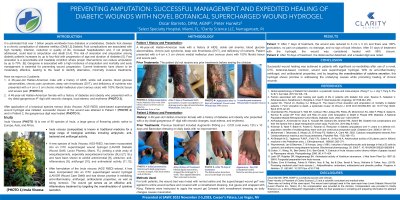Case Series/Study
(CS-021) Preventing Amputation: Successful Management and Expedited Healing of Diabetic Wounds with Novel Botanical Supercharged Wound Hydrogel*

Wound healing in patients with diabetes can be life threatening if not diagnosed timely, promptly treated, and managed properly. Implications of wound progression include decline in function, quality of life, hospitalization, and could lead to amputation and death. Chronic ulcers can cause debilitating pain and may show continuous wound breakdown instead of healing. Gangrene results from infection and/or ischemia and often presents in a digit or extremity. Identification of proper treatment presents a therapeutic challenge, and it is critical to target the underlying cause to optimize healing and prevent wound progression.
Presented is the successful treatment of a chronic ulcer and gangrenous digit using a botanical wound care hydrogel* with anti-inflammatory and antibacterial properties.
Methods:
Patient 1 Presentation: A Haitian-American 46-y.o. male with history of AIDS, sickle cell anemia, blood glucose abnormalities, chronic pain syndrome, deep vein thrombosis (DVT), and deficiency of macronutrients. Patient was diagnosed with a 4 cm x 3 cm chronic medial malleolus ulcer (venous ulcer) with 100% fibrotic tissue and severe pain on palpation. Patient did not receive any prior treatments prior to seeing the clinician.
Patient 2 Presentation: A Haitian-American 46-y.o. female with a history of diabetes and obesity. Patient presented with a dry distal gangrenous 4th digit with necrotic changes, local edema, and erythema. Previous treatment included Augmentin 500mg p.o Q12h (oral every 12h) x 10 days and Bactroban dressing on daily basis with no improvement.
For both patients, the wound bed was rinsed with normal saline and the supercharged wound gel* was applied to entire wound surface and covered with a nonadherent dressing, 4x4 gauze and wrapped with Kling. Patients were instructed to apply the wound gel 2x/week with nonadherent dressing as daily changes causes maceration.
Results: Patient 1: After 8 days of treatment, the wound size reduced to 3 cm x 3 cm and there was 100% granulation, no pain on palpation, no drainage, and no sign of local infection. After 51 days of treatment, the wound was considered healed with 98% closure.
Patient 2: After 70 days of treatment, the distal eschar detached, and a healed digit was noted.
Discussion: Successful wound healing was achieved in patients with significant co-morbidities after use of a novel, OTC, botanical-based, wound care supercharged hydrogel. With its anti-inflammatory, antifungal, antibacterial properties, nontoxicity, and by targeting the overstimulation of cytokine secretion, this hydrogel shows promise in addressing the underlying causes while promoting healing of chronic wounds.
Trademarked Items:
References: 1. International Diabetes Federation; The Diabetic Foot; Brussels, Belgium, International Diabetes Federation, 2020. Accessed 1 August 2022. Available from https://www.idf.org/our-activities/care-prevention/diabetic-foot.html
2. Buttolph A, Sapra A. Gangrene. [Updated 2022 Aug 8]. In: StatPearls [Internet]. Treasure Island (FL): StatPearls Publishing; 2023 Jan-.
3. https://www.cdc.gov/diabetes/data/statistics-report/index.html
4. Tay S, Abdulnabi S, Saffaf O, Harroun N, Yang C, Semenkovich CF, Zayed MA. Comprehensive Assessment of Current Management Strategies for Patients With Diabetes and Chronic Limb-Threatening Ischemia. Clin Diabetes. 2021 Oct;39(4):358-388.

.png)